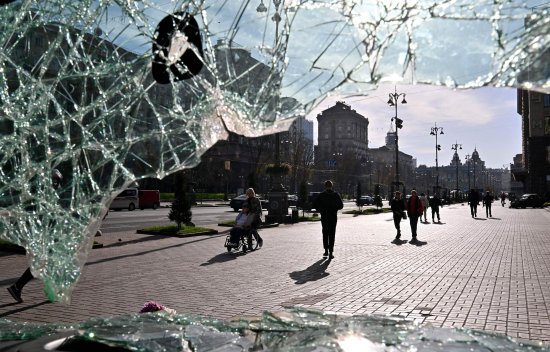
Minister Yulia Svyrydenko lays out her government's vision to repair its war-torn economy.
In the first months of Russia’s full-scale invasion of Ukraine, our country’s economic survival depended on swift and dramatic action—a strategy everyone adopted, from small businesses to our biggest industries.
After Ukraine’s GDP shrank by a staggering 29% in 2022, no one believed our beleaguered war-time economy would make a significant recovery. In April 2023, the World Bank predicted a modest GDP growth rate of 0.5% for the year. But we’ve seen solid growth for the last several months, and the results are in: GDP grew nearly 5% in 2023.
Despite so many unfavorable forecasts, Ukraine’s tenacity paid off, thanks in large part to the courage of entrepreneurs and the support of our international partners.
[time-brightcove not-tgx=”true”]
Now, our strategy for 2024 is clear: we will accelerate recovery, stimulate development of the manufacturing sector, increase exports, attract increased investment into the real sectors of the economy, and, generally speaking, create new investment opportunities. Such growth is necessary for our economic self-sufficiency, so that we can cover the majority of our war-time expenses and be less dependent on international financial assistance, which continues to be vital for us.
This is precisely the purpose of our collaboration with Penny Pritzker, the U.S. Special Representative for Ukraine’s Economic Recovery. Working with the Biden Administration, we have a clear vision of the necessary steps for strengthening the Ukrainian economy over the next 12-18 months. It’s also a shared goal of the Ukraine Facility, a four-year, €50 billion ($55 billion) program proposed by the E.U.
In collaboration with our American partners, we have developed a plan consisting of very specific steps. If enacted correctly, these measures could enable our economy to grow further.
Our highest priority is the ability to sell our goods around the world unhindered. In 2021, our average monthly export revenue amounted to $5.6 billion. When the Black Sea Grain Initiative expired in July, that decreased to $2.5 billion. Launching our own Alternative Black Sea Corridor of safe shipping lanes resulted in success, providing stable growth: sea freight traffic increased 70% for November compared to October. And it grew up to 30.7% in December compared to November. We expect that growth to continue.
We’re also increasing the capacity of E.U.-Ukraine Solidarity Lanes, primarily in Moldova and Romania. In the port of Constanta, a new berth opening in February will enable the transfer of Ukrainian products from barges to large sea vessels. Meanwhile, we’re improving rail capacity for the transport of goods to Danube ports. The development of logistics and transport infrastructure will continue to be a core element of our cooperation with the U.S. and E.U.
Our next objective is the restoration of the energy sector. Thanks to the tremendous efforts of our energy workers, a big part of our energy systems damaged by Russian attacks have been repaired. But Ukraine’s economy cannot yet operate at full capacity during the winter months. To meet this challenge, we will continue to develop electricity generation throughout the year, primarily via nuclear power, green energy, and interconnectors with the E.U. power grid. Notably, Ukraine is now fully integrated into the E.U.’s common electricity market.

Another high priority is the development of the Ukrainian Defense Industry. It’s currently contributing 3.6% to Ukraine’s GDP. We live in a situation where ensuring a technological advantage over the enemy becomes the key driver of industrial production and innovation, and it’s imperative that we localize armament production as much as possible—both for economic growth and national security. To this end, one of our goals for 2024 is to launch five joint ventures in Ukraine, together with Western arms manufacturers, which will involve the transfer of advanced technologies in partnership with Day & Zimmermann, Northrop Grumman, Lockheed Martin, and Raytheon.
Beyond defense investments, we have made significant progress in creating capital-access mechanisms for all private investments into our economy. This includes providing insurance for investment projects within the framework of the Export Credit Agency, guaranteeing loans from international financial institutions within the framework of the Ukraine Facility, and war-risk insurance infrastructure. We need these investments so that the economy will grow further.
Despite all this progress, the sheer scale of reconstruction needed demands that we do not bear all the costs. For this reason, we remain dedicated to the confiscation of frozen Russian state assets, estimated at around €300 ($325) billion. Interest from these funds continue to accrue, generating €4-6 ($4.3-6.5) billion of profit annually in the E.U. alone. We hope to receive all frozen assets as compensation for the damage caused, and we are making progress toward that goal.
All these objectives are designed to make the Ukrainian economy more self-sufficient. Behind much of this is regular people. Self-sufficiency means having the resources to support our soldiers on the front lines and civilians in the rear; to be able to support businesses, from small enterprises to large factories; to integrate veterans in civilian life and provide dignified conditions to those who defend our land; to rebuild or destroyed infrastructure; and to create the conditions for millions of Ukrainians abroad to return home.
The Ukrainian economy has endured the toughest of challenges. We understand that the longer the war lasts, the harder these challenges will be to overcome. But we’ve already gathered laudable achievements, reliable support from our partners, and actionable plans for continued development. Ukraine has exceeded expectations many times over—going from a 29% GDP contraction in 2022 to returning to growth the next year. We can do even better in 2024.
Yulia Svyrydenko is the First Deputy Prime Minister and Economy Minister of Ukraine. She is a member of the 2023 TIME100 Next list.